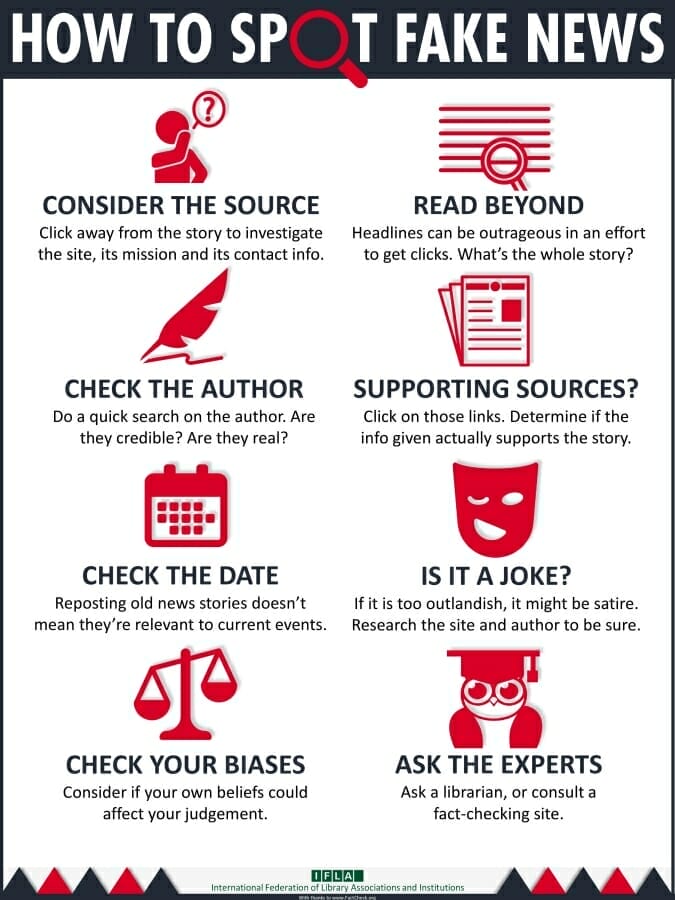The ability to tell accurate news from fake news is an important skill that you'll use for the rest of your life. This Research Guide will give you valuable insight in telling fact from fiction online.
5 Signs a News Story is Fake
1. You can't verify it's claim
A fake news article may or may not have links in it tracing its sources; if it does, these links may not lead to articles outside of the site's domain or may not contain information pertinent to the article topic.
2. It appeals heavily to emotion
Fake news plays strongly on your feelings—it makes you angry or happy or scared. The aim is to make you leap quickly to conclusions, without doing any pesky fact-checking.
3. Authors usually aren't experts
Fake news is often authored (or disseminated) by trolls, provocateurs, or sometimes well-meaning, but uncritical people online. Rarely is the author a well-respected expert or authority on the topic.
4. It can't be found anywhere else
If you look up the main idea of a fake news article, you might not find any other credible sources or trusted news outlets reporting on the issue.
5. It comes from a fake site
Did your article from abcnews.com.co? Or realnewsrightnow.com? Beware of lookalike sites and sites that publish parody articles.
4 Categories of Fake News
There are four broad categories of fake news, according to media professor Melissa Zimdars of Merrimack College.
- Category 1: Fake, false, or regularly misleading websites that are shared on Facebook and social media. Some of these websites may rely on “outrage” by using distorted headlines and decontextualized or dubious information in order to generate likes, shares, and profits.
- Category 2: Websites that may circulate misleading and/or potentially unreliable information
- Category 3: Websites which sometimes use clickbait-y headlines and social media descriptions
- Category 4: Satire/comedy sites, which can offer important critical commentary on politics and society, but have the potential to be shared as actual/literal news
No single topic falls under a single category - for example, false or misleading medical news may be entirely fabricated (Category 1), may intentionally misinterpret facts or misrepresent data (Category 2), may be accurate or partially accurate but use an alarmist title to get your attention (Category 3) or may be a critique on modern medical practice (Category 4.) Some articles fall under more than one category. Assessing the quality of the content is crucial to understanding whether what you are viewing is true or not. It is up to you to do the legwork to make sure your information is good.
Infographic: How to Spot Fake News

Other tips for fact checking and avoiding fake news
- When you open up a news article in your browser, open a second, empty tab. Use that second window to look up claims, author credentials and organizations that you come across in the article.
- Fake news spans across all kinds of media - printed and online articles, podcasts, YouTube videos, radio shows, even still images. Be prepared to double-check everything.
- Beware of confirmation bias. Just because you might agree with what an article is saying doesn't mean it's true.
- As Mad-Eye Moody said in Harry Potter and the Goblet of Fire, "Constant Vigilance!" Always be ready to fact check.
- Even the best researchers will be fooled once in a while. If you find yourself fooled by a fake news story, use your experience as a learning tool.
License and Attribution
